últimas noticias
Categorías de Producto
Caliente Productos
-
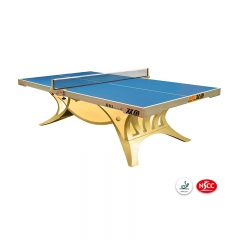
Tabla de Tenis de Mesa Premium para Campeonatos Volant King
Esta mesa de tenis de mesa premium es apta para campeonatos. Aprobado por la ITTF y NSCC. Tren de rodaje de plata + luz azul
Lee mas -
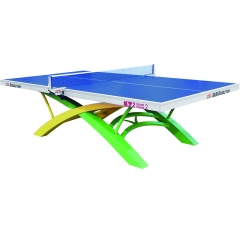
Mesa oficial de tenis de mesa para el torneo Volant Dream 2
Mesa de ping pong oficial Volant Dream 2 para competiciones internacionales diseñadas por Double Fish Sports.
Lee mas -
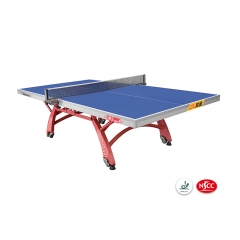
Mesa Oficial de Tenis de Mesa para Competitons XIANGYU 328
Tabla plegable doble superior del tenis de vector, diseño compacto El nuevo sistema de plegado minimiza el riesgo de lesiones durante el almacenamiento y el movimiento de la mesa. Tabla de tenis de mesa aprobada por la ITTF.
Lee mas -
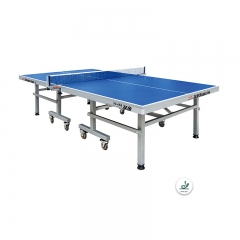
Mesa oficial de tenis de mesa duradera para el World Tour 99-45B
La ITTF aprobó una mesa de ping pong duradera oficial para un torneo internacional. Espesor del tablero de mesa: 25 mm CALIDAD DEL TORNEO - Esta mesa de nivel profesional está diseñada para el más alto nivel de competencia. PERFECT FOR FAMILIES: ofrece juegos premium para todas las edades. Vaya cabeza a cabeza o pliegue para practicar individualmente. Los soportes de acero de calibre grueso de 2 pulgadas cumplen con los desafíos más difíciles. Un gran centro de mesa para su sala de juegos, estudio o gimnasio. FÁCIL ENSAMBLAJE: comience a jugar en minutos con un simple ensamblaje. La red de alta calidad está equipada con abrazaderas de bloqueo que se unen fácilmente.
Lee mas -
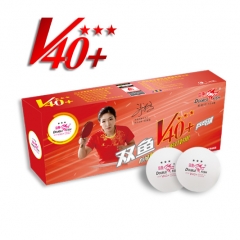
Mejor calidad doble pescado V40 + Volant 3 estrellas pelota de tenis
Doble pescado V40 + Volant 3 estrellas bola de tenis de mesa es confirmar a los últimos estándares técnicos de la ITTF T3.
Lee mas -
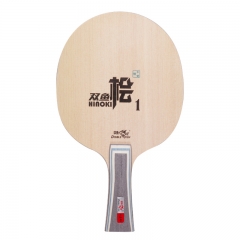
Double Fish QIJI Lámina para tenis de mesa
Doble pescado QIJI todo terreno de tenis de mesa, que es la mejor tabla de tenis de mesa de tenis de mesa, & nbsp; Perfecto para el jugador allround tradicional
Lee mas
Rastreando el origen de Double Fish: el desarrollo de la fábrica de tenis de mesa de Guangzhou (Parte 1)

Desde la fundación de la República Popular China, Guangzhou ha promovido constantemente el proceso de industrialización y modernización socialista mediante la implementación del plan quinquenal para el desarrollo económico y social nacional. Durante este período, Guangzhou estableció inicialmente un sistema económico socialista, sentando las bases para la promoción integral de la construcción socialista.
En el otoño de 1959, se estaba celebrando una importante reunión del comité filial del partido en un desolado cobertizo con techo de paja en Duntouji②, al este de Guangzhou. El secretario de la sucursal, Liao Honglue, transmitió la decisión del comité distrital de poner fin al trabajo de más de 30 fábricas de la industria alimentaria, cultural y educativa en el distrito central③ para construir aquí una base de producción de materias primas químicas. En la reunión, todos discutieron y formaron una nueva fábrica con contabilidad independiente tomando el equipo de ingeniería civil y los trabajadores que quedaban en cada fábrica. Pronto, los superiores aceptaron su sugerencia y dieron una severa instrucción de "sólo se permite el éxito, no se permite el fracaso". Así nació el nombre "Fábrica de productos químicos alimentarios Chenggong".
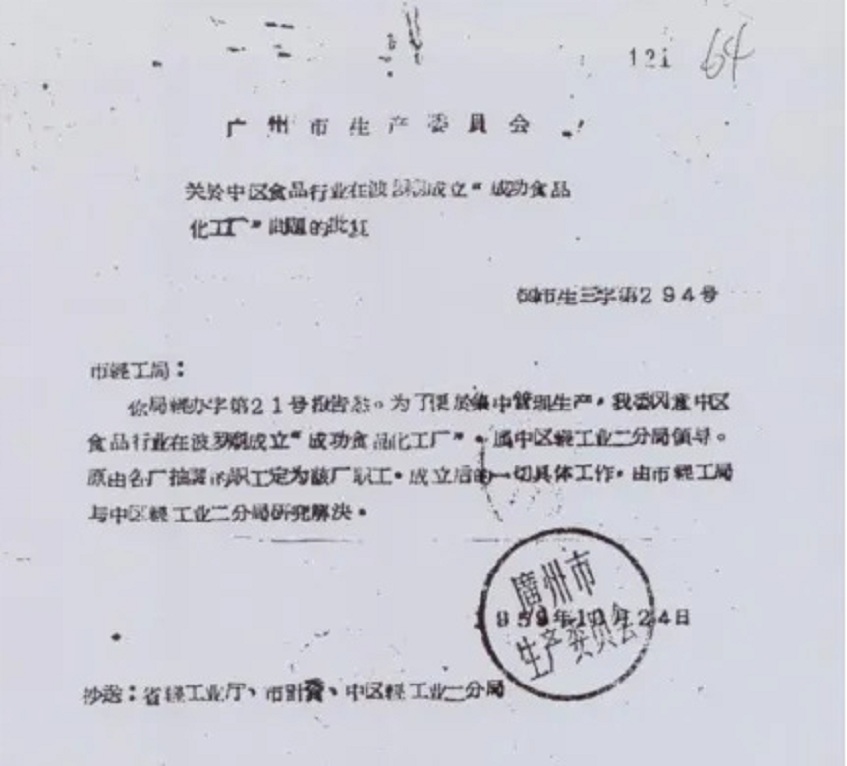
Respuesta del Comité de Producción Municipal de Guangzhou sobre el establecimiento de la fábrica de productos químicos alimentarios Chenggong
En marzo de 1960, la recién nacida fábrica decidió trasladarse al nuevo emplazamiento de Polo Temple④ en la orilla norte⑤. Una ladera áspera y árida, una nueva fábrica con unos "cimientos" escasos, se enfrentaba a las penurias del "cielo sobre la cabeza y la naturaleza salvaje bajo los pies". ¿Se puede operar la fábrica en esta situación? Los trabajadores dijeron: "Las personas que comen comidas preparadas tendrán huesos blandos. No importa lo difícil que sea, no es tan difícil como vivir en una choza con techo de paja y dormir en el barro cuando llegaron por primera vez a Duntouji.
"①El contenido de este artículo está compilado principalmente en base a los datos históricos de Chenggong Table Tennis Factory y las 303-304 páginas del Volumen 5 (Parte 1) de "Guangzhou City Chronicles".
②Según los recuerdos de Li Zhouchang, la antigua fábrica Director de la fábrica de tenis de mesa Guangzhou Chenggong en la década de 1980, Dongjiao Duntouji está cerca de Nangang en el distrito de Huangpu.
③El Distrito Central fue abolido en 1960, y la mayor parte del Distrito Central fue asignado al actual Distrito de Yuexiu, y algunas áreas fueron asignadas a Liwan. Distrito y distrito de Haizhu
④El Templo de Polo, también conocido como Templo de Nanhai y Templo del Este, está ubicado en la aldea de Miaotou, distrito de Huangpu, Guangzhou. Fue construido en el año 14 de Kaihuang en la dinastía Sui (594). una historia de más de 1.400 años
⑤ Como el sitio de la fábrica está cerca del estuario del río Perla, la composición del agua de mar circundante afecta la producción de materias primas químicas, por lo que se decidió trasladar la fábrica a una ubicación más adecuada. "
There are ways to deal with poverty. If there is no house, build it yourself!" So, they transported all the building materials from Duntouji - whether it was a straw shed, bricks and tiles, or a stove, or even a newly planted peach tree - across the river without omission, and started to build a new factory on this barren land. On this barren hillside, cadres, workers, and hundreds of heroes were engaged in base construction. Those who burned lime, carried sand and water, moved bricks to build walls, and nailed metal frames... During the day, it was steaming; at night, it was bustling. Everyone was united, and the soil turned into gold, and the factory buildings and dormitories were built.
Although the factory building was built, it still faced many challenges. But the workers were not afraid of difficulties and began to use local methods to produce chemical products to meet the urgent needs of industrial production at that time. They set about producing basic chemical raw materials such as hydrochloric acid, pure sulfur, ethanol, monomer flavors, barium sulfide and hydrosulfuric acid, and supplied them to many factories including the Asia Soda Factory to support the development of Guangzhou's industry.
At this time, the table tennis sport in New China had gradually developed, constantly pushing the domestic table tennis sport to a new peak.
In 1959, the world was shaken by a Chinese athlete. On April 5 of that year, the 25th World Table Tennis Championships was held in Dortmund, the former West Germany. The 21-year-old table tennis player Rong Guotuan defeated many world players in succession, and finally faced the Hungarian veteran Sido who had won the world championship nine times. Rong Guotuan played steadily after losing the first game, and finally won three games in a row, winning the men's singles world championship for China. This is the first world championship since the founding of New China.
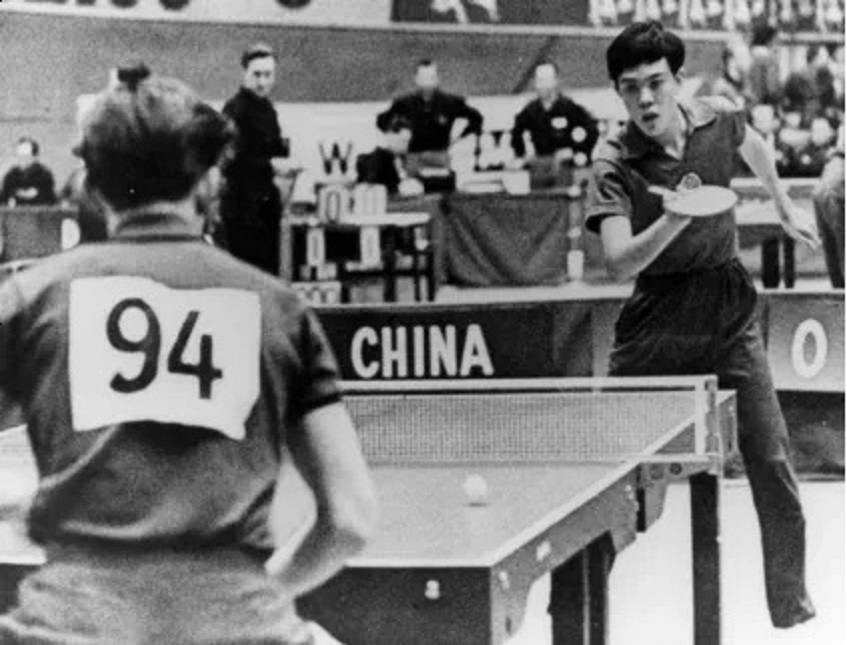
The 25th World Table Tennis Championships, Rong Guotuan is in full swing
Almost at the same time as Rong Guotuan won the championship, the International Table Tennis Federation agreed to host the 26th World Table Tennis Championships in Beijing. After the news came out, people rushed to tell each other, and all parties showed concern and support. Welcoming the "26th" and playing well in the "26th" has become a major event across the country. As a result, the table tennis craze swept across China, and the demand for table tennis equipment increased day by day.
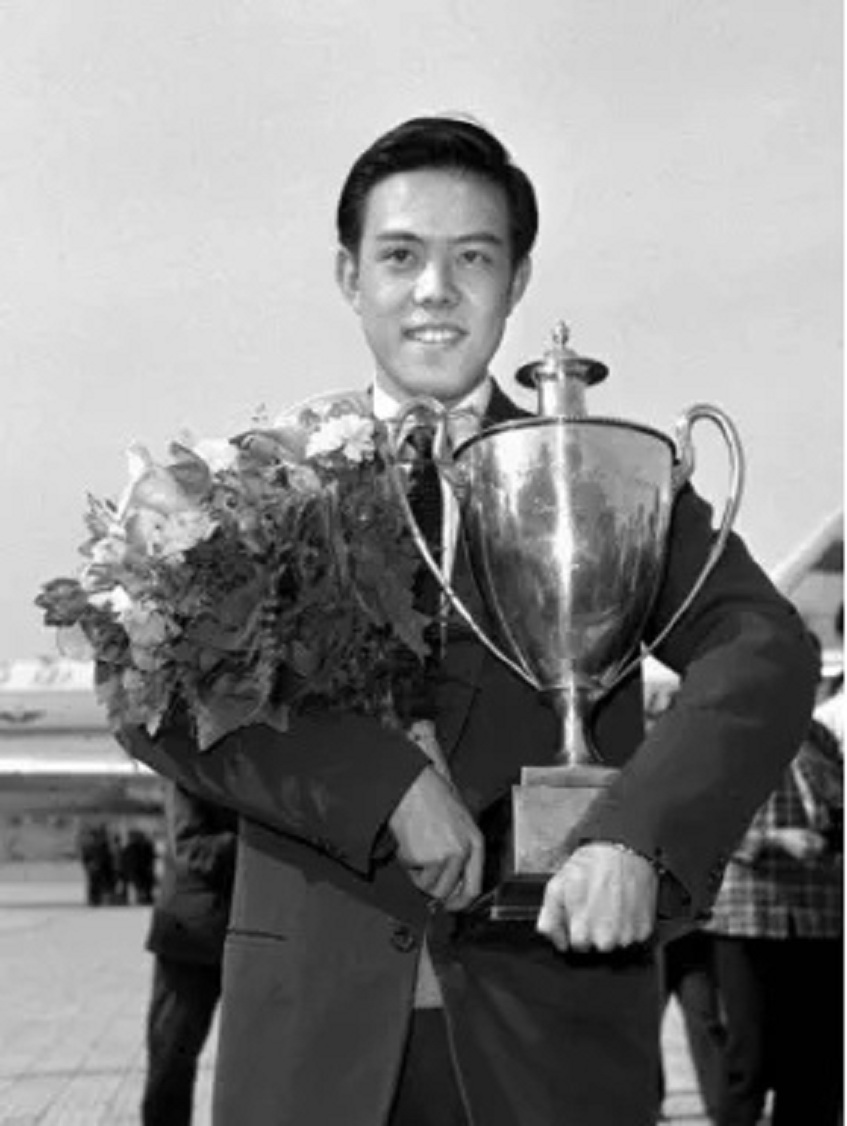
China's first world champion Rong Guotuan
In 1960, in response to Chairman Mao's call for "developing sports and strengthening the people's physique" and to meet the people's need for table tennis when developing sports, in September of that year, the superiors decided that the future product task of Chenggong Factory would be to produce table tennis. The factory name was changed to Chenggong Table Tennis Factory, and it was decided to integrate a table tennis trial production team of Guangzhou Guoqun Musical Instrument Factory ⑥ into it. Unexpectedly, this production conversion decision determined the fate of the birth of the first professional table tennis factory in Guangzhou, and even had a profound impact on the development of Chinese table tennis equipment!
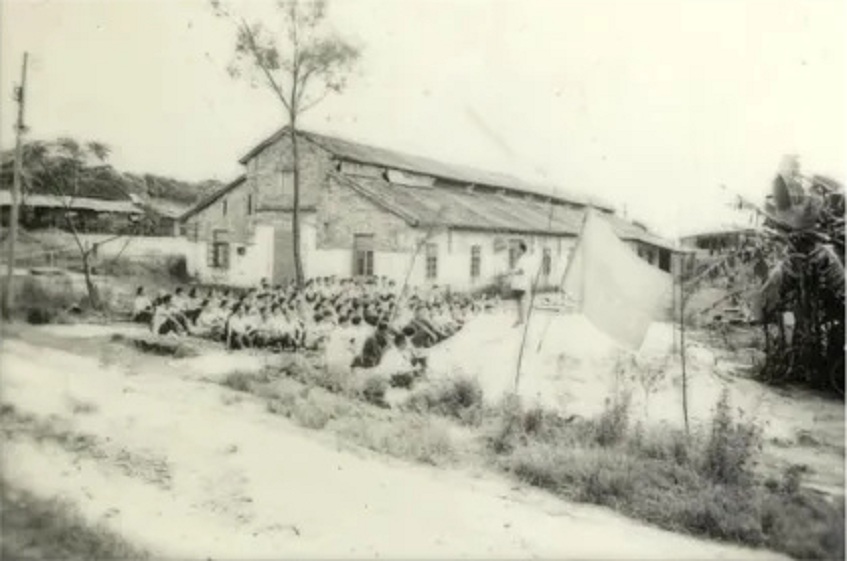
The appearance of the factory near the Polo Temple in the last century
When the Chenggong Table Tennis Factory received the task of switching to the production of table tennis balls, it faced many difficulties: first, it had no technology to produce table tennis balls; second, it had no machinery and equipment, only a few simple tools such as vises, hand drills, and broken bellows; third, it had no industrial water, only a drinking well; fourth, it had no suitable factory buildings, only four borrowed earthen houses for temporary residence. All the employees of the factory carried forward the spirit of "self-reliance and hard work", relying on simple tools to make parts and equipment; dig channels and build pools to draw mountain water, and use cars to draw river water during droughts; build earth stoves, borrow large pots, and use boiling water to "cook" table tennis balls⑦
"⑥According to the "Guangzhou City Annals", in the early 1950s, Guangzhou Guoqun Musical Instrument Factory once produced toy table tennis balls, with a monthly output of about 50,000.
⑦The original table tennis ball process: First, the 0.55 mm thick raw material is cut into discs through a punching process. Then, these discs are heated in hot water to soften, and then placed in a pressing mold and pressed into two hemispherical shapes with edges. After the initial forming is completed, the edge rings of the two hemispheres are cut off to ensure the neatness and uniformity of the edges. Subsequently, the two hemispheres with the edge rings removed are precisely bonded by using a special solvent, and the bonded spheres are soaked in warm water for maintenance. Finally, Put the bonded sphere into the mold and heat it in a medium with a temperature higher than 100 degrees (such as water or wax solution) to eliminate the bonding seams and ensure the overall strength and shape of the sphere. The process of "boiling" ping-pong balls refers to the last step, which is to heat it in a medium with a temperature higher than 100 degrees (such as water or wax solution) to eliminate the bonding seams. "
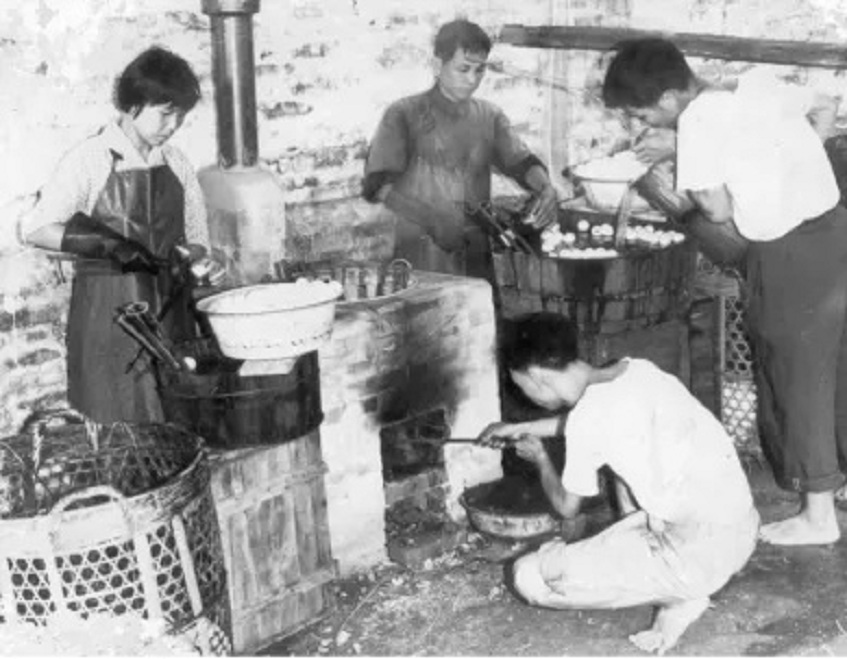
Early ping-pong ball production
Aunque en ese momento no existía una marca registrada ni estándares de calidad claros, este lote de pelotas de ping-pong encarnaba los innumerables esfuerzos y sudor de la generación anterior de personas de Double Fish, brillando con la luz ideológica de "autosuficiencia y trabajo duro". ", ¡y finalmente salió con éxito!























 Overseas business:(020)8431 9554
Overseas business:(020)8431 9554
 13829778212
13829778212